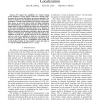Free Online Productivity Tools
i2Speak
i2Symbol
i2OCR
iTex2Img
iWeb2Print
iWeb2Shot
i2Type
iPdf2Split
iPdf2Merge
i2Bopomofo
i2Arabic
i2Style
i2Image
i2PDF
iLatex2Rtf
Sci2ools
IJRR
2008
2008
Active Electrolocation for Underwater Target Localization
We explore the capabilities of a robotic sensing system designed to locate objects underwater through active movement of an electric field emitter and sensor apparatus. The system is inspired by the biological phenomenon of active electrolocation, a sensing strategy found in two groups of freshwater fishes known to emit weak electric fields for target localization and communication. An analytical model for the observation of simple targets is used to qualitatively predict some characteristics of the sensor including the detection distance as a function of sensor noise. We characterize the performance of the robot using different automatic electrolocation controllers, objects, and water salinity. We demonstrate successful electrolocation both in the conditions in which it is naturally observed, in low conductivity water, as well as in conditions in which it is not observed, in water of ocean salinity. For the electrolocation experiments using an active controller based on a probabilisti...
| Added | 12 Dec 2010 |
| Updated | 12 Dec 2010 |
| Type | Journal |
| Year | 2008 |
| Where | IJRR |
| Authors | James R. Solberg, Kevin M. Lynch, Malcolm A. MacIver |
Comments (0)

